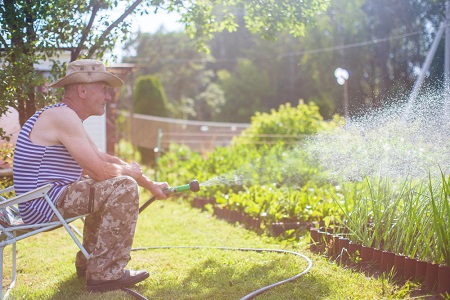Gardens Need Heatwave Protection
Gardens, Like Humans, Need Heatwave Protection

Everyone is complaining about the heatwave. But your garden is not so lucky. It suffers the heat in silence and often you only notice how much it’s suffering when you see the plants wilting and spot other signs of heat-related damage. If you find the problem in time, salvaging the dying plants may be possible. If not, say goodbye and start planning for new planting. Remember that blistering hot summers are the new norm and what happened this year will continue to happen in the future. So, why not think about protecting the garden from the heat?
We all complain about the inaccuracy of weather forecasting, but the fact is that evolving technology is making it more accurate and when it comes to periods of extreme heat, there are normally a few days of warning before it sets in. This is when you can take steps to keep your garden from “frying”.
Also Read: How to Clean a Landscape? Landscape Seasonal Clean-Up and Renovation Guide
Water
Like humans, plants lose water in hot conditions. It may be obvious, but it’s surprising how many homeowners forget about the need to increase watering when it’s hot. The issue is not just about watering, but about how much water is needed by the plants and when to water them.
- When watering the plants, check to see if the soil is already moist and/or soggy. If so, there is enough water for the day so don’t water any more. Overwatering can be as bad as allowing the plants to dry up.
- It may seem like a no-brainer to do the watering when it is the hottest to allow the plants to cool down, but this is wrong. This is the time the plants are focused on surviving the heat and not on taking up water. Early mornings, when the temperature is lower and the plants can better absorb the moisture is the best time to do the watering.
Don’t Fertilize
The heat also prevents the plants from absorbing the nutrients in the fertilizer. Fertilizer that is not taken up by the plants and remains in the soil can cause heat to build up in the ground and damage the plants. Fertilize once the temperature drops.
Mulch
Adding a layer of mulch around plants and trees will create an extra layer of heat protection and help in keeping the roots from getting damaged by the heat.
Shade
Unlike humans, plants can’t move into the shade to avoid the scorching sun. That means you have to take the shade to them. You can buy shade cloth and landscape burlap from big-box stores and nurseries or choose DIY options. From placing a patio chair over a low-growing plant to carrying pots indoors and making your shade protected, there is a lot you can do.
Also Read: How Climate Change Can Affect Your Garden?
Avoid Pruning
Avoid cutting off sunburned growth. It may look ugly, but it serves a purpose. It continues to protect the interior of the plant from the heat. Postpone any pruning until the heat wave subsides and the temperature drops.
All these tips are tried and proven. But they may not be enough to protect your prized landscape. If you want to properly protect the garden you love and keep it healthy and evolving to become what you want it to be in the future, the best option is to go for expert care. A professional landscaping service will have both the horticultural expertise and local soil and climate knowledge to do all that can be done to protect your garden from the heat and the other arrows that nature fires at it. Landscape seasonal clean-up and landscape renovation are among the various services a professional landscaping and garden maintenance company will provide.
- Aug 17, 2023
